Kanji for East: 東 (tō / higashi)
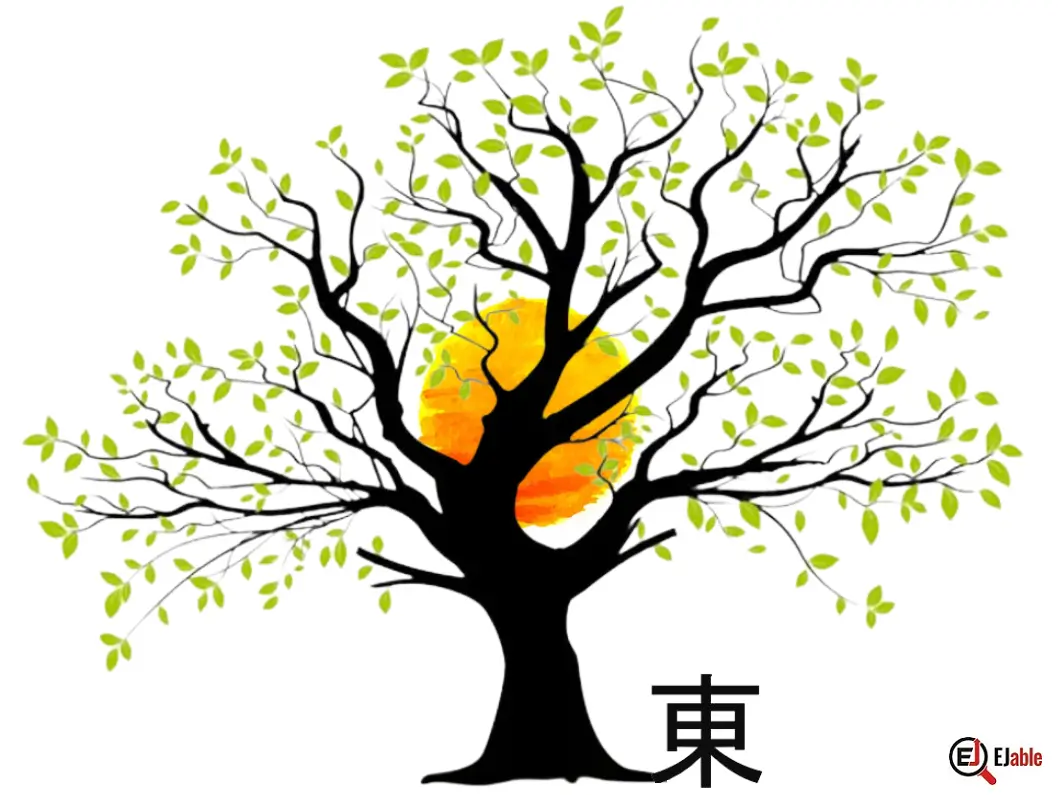
The Japanese Kanji for “East” is 東.
The kun’yomi (Japanese reading) pronunciation of the Kanji 東 is “higashi” (ひがし), and the on’yomi (Chinese reading) pronunciation of 東 “tō” (トウ).
東 is used extensively in Japanese for indicating direction (east), and it’s a common component in place names, including 東京 (Tokyo), which means “Eastern Capital.”
東 quite commonly appears in Japanese names and is used in 9356 names. However, in names, it is pronounced as “ai” (あい), “agari” (あがり), “azuma” (あづま), “ko” (こ), “saki” (さき), “shino” (しの), tō (とお), “haru” (はる), “higa” (ひが), or “moto” (もと).
The Kanji 東 is constructed with 8 strokes. It is part of the JLPT N5 syllabus (please check the list of JLPT N5 Kanji). In Japanese schools, this Kanji is taught in grade 2.
Origin of the Shape 東
The following illustration shows the ancient shape of the kanji 東 in Oracle Bone Script, Bronze inscription, small seal script, and how we write it today:
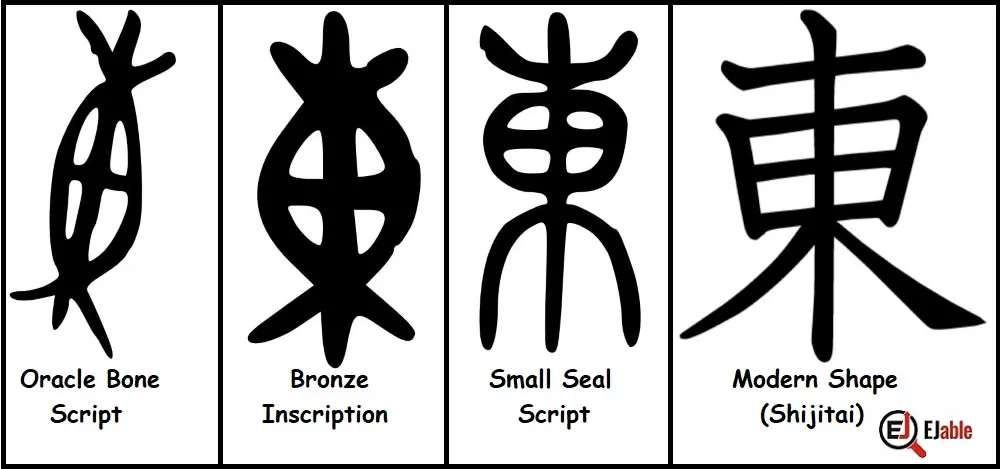
As illustrated, the shape of the kanji has evolved from having rounded strokes to simpler straight-line strokes.
It is assumed that the ancient shapes in the Oracle Bone Script and Bronze Inscription denoted a bundle tied at both ends and in the middle with a rod passing through it. However, this assumption behind the shape does not connect it with its meaning as East. Instead, we can also consider the following two possibilities behind those shapes:
- An enclosure with a star inside and rays coming out to imply that the stars of the night are getting hidden, and the sun is coming out. This logic ties the shape to the East direction.
- The ancient shapes may also represent the sun in the middle, with the rays coming out of it at two ends to denote sunrise.
Mnemonic to Remember 東 to Associate it with “East”
It is very easy to remember the Kanji 東 for its meaning of “East” if we already know the Kanji characters of “tree” and “sun“. For the ready reference, please check the following illustrations for these two Kanji:
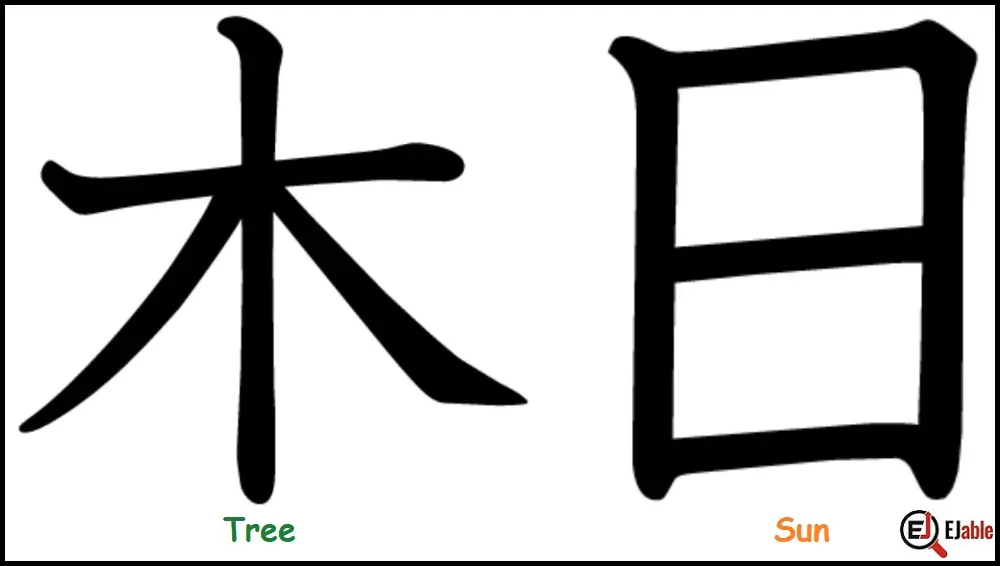
Now, if we observe the shape of the Kanji 東, we can see that it combines the Kanji for the tree (木) and, in the middle, the Kanji for the sun (日). With this logic, the following illustration makes a good pictorial mnemonic to remember the shape 東 to denote the sun rising behind a tree to associate this kanji with the East direction.
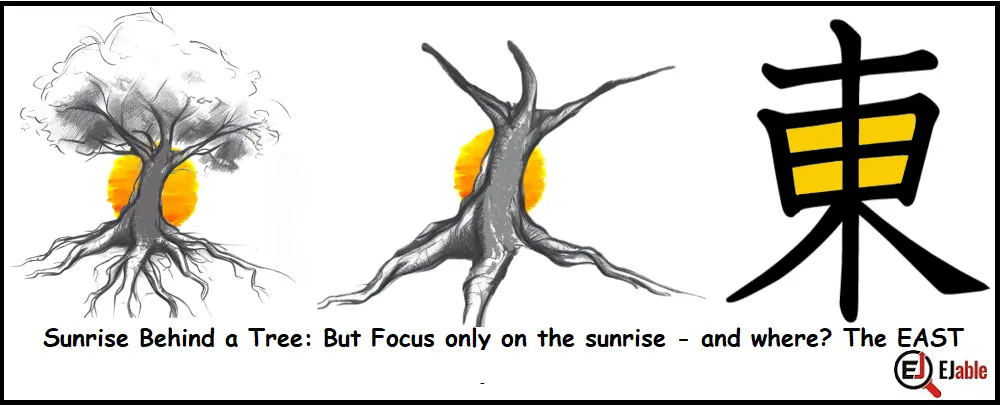
Stroke Order for the Kanji 東
The following illustrations show the order of the 8 strokes to write the Kanji 東:
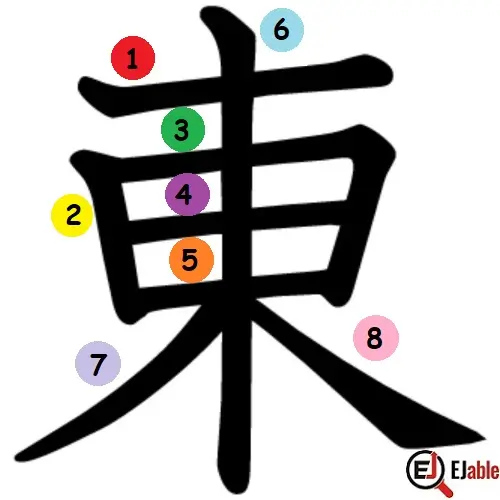
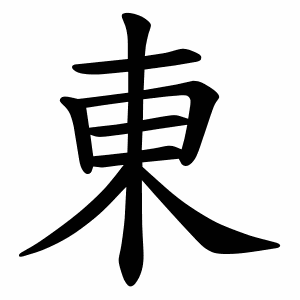
東 as a Component in other Kanji Characters
The Kanji 東 is used as a component in 21 Kanji characters, out of which the following 6 are Jōyō (commonly used) Kanji.
- 練 (れん / ren): Practice, refine.
- Explanation: Combines 糸 (ito, meaning “thread” or “yarn”) with 東. The idea here could be associated with the methodical, disciplined process involved in weaving or threading, metaphorically extended to the concept of practicing or refining a skill.
- 凍 (とう / tō): Freeze.
- Explanation: Incorporates 氵 (the “water radical“) with 東. This could symbolize the transformation of water as it reaches the colder regions (implied by 東 as east, where the sun rises, but here contextually suggesting coldness).
- 陳 (ちん / chin): Exhibit, display; also, stale or old.
- Explanation: Combines 阝 (the “Hill” or “Village” radical) with 東. This Kanji is often used to describe laying things out (in a store, for example) or presenting them clearly, possibly relating to the alignment or orderly arrangement as things are set out from east to west.
- 棟 (とう / tō): Ridgepole; main building.
- Explanation: Joins 木 (ki, meaning “tree” or “wood”) with 東, referring to the main structural beam in a building, crucial for the building’s support, potentially implying a pivotal or “eastern” cornerstone in architecture.
- 欄 (らん / ran): Railing, column; also used to refer to fields or categories in tables.
- Explanation: This character combines 木 (wood) and 東, suggesting the structured, segmented parts of a fence or railing, aligning or arraying like rays from the east.
- 錬 (れん / ren): Forge, refine (metals).
- Explanation: Pairs 金 (kin, meaning “metal”) with 東, illustrating the process of refining or smelting metal, which involves methodical, disciplined techniques akin to those used in weaving or other crafts that require precision and order.
東 Kanji in Compounded Words
There are 191 Japanese words that begin with the Kanji for “East” (東), and it appears in 243 words overall.
Examples of Kanji 東 in Compounded Japanese Words
- 東京 (とうきょう / Tōkyō): Tokyo— the capital city of Japan, literally means “Eastern Capital.”
- 東西 (とうざい / tōzai): East and west— often used to describe geographical orientation or cultural differences across regions. Tōzai is also the name of one of the subway lines in Tōkyō.
- 東北 (とうほく / Tōhoku): Northeast— a geographical region in Japan.
- 東南アジア (とうなんアジア / Tōnan Ajia): Southeast Asia— referring to the geographic region southeast of Japan.
- 東洋 (とうよう / Tōyō): The Orient— broadly referring to East Asia or Eastern cultures.
- 東側 (ひがしがわ / higashigawa): The East side— side of a location or object that is towards the east.
- 東口 (ひがしぐち / higashiguchi): East exit— commonly used in stations and buildings to denote exits facing east.
- 東風 (こち / kochi): East wind— a wind blowing from the east.
- 東進 (とうしん / tōshin): Advancing eastward— often used metaphorically to describe expansion or movement toward the east.
- 東欧 (とうおう / Tōō): Eastern Europe— the eastern part of the European continent.
- 東京都 (とうきょうと / Tōkyō-to): Tokyo Metropolis— the official name of the Tokyo area, which includes the city and surrounding regions.
- 東海 (とうかい / Tōkai): The area along the Pacific coast of central Japan.
- 東方 (とうほう / tōhō): Eastern direction— can also refer to countries or regions located to the east.
- 東線 (とうせん / tōsen): East line— a train line or route that runs predominantly in an easterly direction.
- 東日本 (ひがしにほん / Higashi Nihon): Eastern Japan— referring to the eastern part of Japan, often used in contrast to Western Japan (西日本).
- 東証 (とうしょう / Tōshō): Short for 東京証券取引所 (Tōkyō Shōken Torihikijo), Tokyo Stock Exchange.
- 東部 (とうぶ / tōbu): Eastern part— referring to the eastern section of a city, country, or region.
- 東京大学 (とうきょうだいがく / Tōkyō Daigaku): The University of Tokyo— one of Japan’s most prestigious universities.
Note: Check other Kanji characters on the page “How to Learn Kanji“.

A long-term ex-pat in Japan, Himanshu comes with an IT background in SAP consulting, IT Business Development, and then running the country operations of an IT consulting multinational. Himanshu is the co-founder and Managing Director of ReachExt K.K. and EJable.com. He is also an Advisory Board Member of a Silicon Valley AI/IoT startup.
